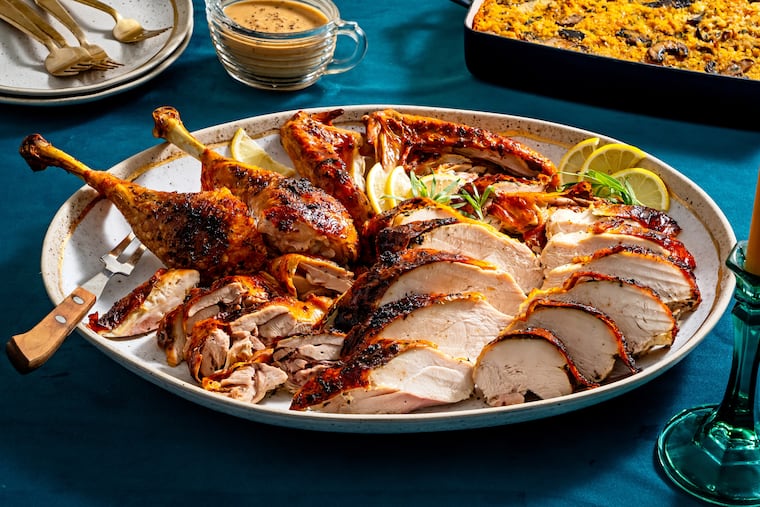Salmonella is common on turkey farms, but it doesn’t need to ruin Thanksgiving
Don't let salmonella be an uninvited guest at your Thanksgiving dinner. Here's what you can do to avoid illness.

As you plan Thanksgiving gatherings with family and friends, you should also prepare for one common uninvited guest: salmonella.
The bacterium is commonly found in poultry and eggs, and can quickly turn a delicious dinner spread into a disaster. About 26,000 people are hospitalized and 400 people die from foodborne salmonella illness annually, according to the CDC.
The best way to prevent illness from salmonella is to thaw your turkey properly, cook it thoroughly, and wash your hands and any kitchen surfaces that come into contact with raw meat.
But federal regulators and academic researchers say there’s more that can be done to reduce the likelihood of the bacterium making its way into your home in the first place.
Why does poultry have salmonella?
“The main problem with most salmonella is the birds are colonized with it. ... You’d never know because they don’t get sick,” said Timothy Johnson, a professor of microbiology at the University of Minnesota’s department of veterinary and biomedical sciences. “You can try to control for it, but the real problem becomes once it enters a facility, it’s really difficult to eliminate.”
A key first step to stop salmonella from making people sick is understanding what strains are most common.
A recent study by the CDC found that certain “serotypes” or strains of salmonella were more common than others among Thanksgiving turkeys. CDC researchers analyzed data from about 846,450 salmonella cases reported between 1998 and 2018 and found that the Reading strain of salmonella was most commonly associated with turkey.
“There are many different types of salmonella‚” said Farrell A. Tobolowsky, a medical epidemiologist with the CDC and the study’s lead author. “They can behave differently — when and where people get sick, how sick they get, and what other foods they’re in. Some types are found in only one type of animal.” By linking specific serotypes and animals, regulators can better anticipate where they may find salmonella.
Salmonella can spread among animals several ways. Often it is passed from an infected bird to its offspring. The bacteria can come into birds’ environment through feed or nesting materials, Johnson said.
Farms and meat processing facilities are required to submit samples for salmonella testing by the Food and Drug Administration. The agency has tightened regulations in an effort to reduce the number of infected meat products that make it to consumers’ dinner tables.
But more testing isn’t necessarily the answer, Johnson said.
“Zero tolerance for salmonella — that sounds great, but it’s really unrealistic because salmonella is a natural colonizer of poultry,” he said. “To ask a producer to be completely salmonella-free, it would be very problematic for our meat supply.”
Rather than testing whether a meat sample contains salmonella, regulators should focus on how much salmonella is present. Research has shown that trace amounts do not typically make people sick; it’s high levels of salmonella that are the real danger to humans, he said.
Johnson and his colleagues are working to help develop new guidelines for salmonella testing, but in the meantime, your best bet is to cook that bird until it’s golden brown and sizzling inside.
How to prevent salmonella illness at Thanksgiving
Here are the CDC’s tips:
Thaw turkey in the refrigerator or in a sink of cold water. Do not thaw turkey on a kitchen counter because if meat is left at room temperature for more than two hours, bacteria can begin to grow more quickly.
Use separate cutting boards and platters for raw turkey, and thoroughly wash any dishes, utensils, and surfaces that come in contact with raw meat.
Wash your hands with soap before and after handling raw turkey.
Cook turkey to an internal temperature of 165 degrees Fahrenheit. Don’t rely on the pop-up temperature indicator that comes with many turkeys — use a meat thermometer. Cooking time will depend on the size of your turkey, but set the oven to at least 325 degrees Fahrenheit, use a roasting pan that’s at least two inches deep, and don’t put the turkey in the oven until it is completely thawed.
Don’t forget the stuffing. If you cook it inside the turkey, make sure stuffing is also cooked to 165 degrees Fahrenheit. Minimize the risk of salmonella in your stuffing by cooking it separate from the bird.
What are the symptoms of salmonella illness?
Diarrhea, fever, and stomach cramps are most common.
Symptoms typically begin six hours to six days after infection and can last up to a week.
Infants, young children, adults aged 65 and older, and people with weakened immune symptoms are most vulnerable to severe illness from salmonella.
What should you do about salmonella symptoms?
Drink extra fluids to prevent dehydration and take it easy. Most people feel better in a few days.
Call your doctor if you are experiencing more severe symptoms, such as bloody diarrhea, frequent vomiting that prevents you from keeping down liquids, or if you have a fever of 102 degrees or higher.
If you are severely ill, your doctor may prescribe antibiotics. People with weakened immune systems or with certain medical conditions such as heart disease, infants, and adults 65 or older may also be prescribed antibiotics.